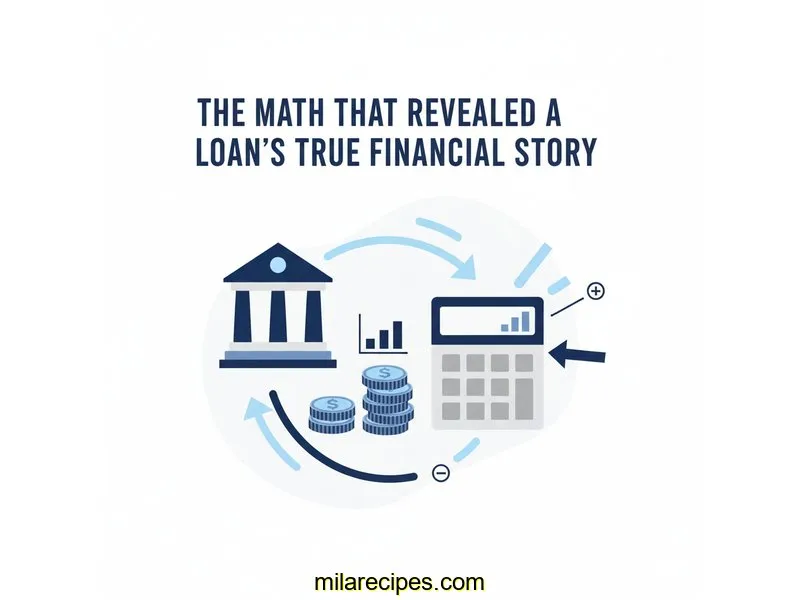
Auto Loan Calculator
Calculate payments over the life of your Loan
Home Blog Privacy Terms About Contact
Calculate payments over the life of your Loan
Home Blog Privacy Terms About ContactPublished on October 26, 2025

My journey into the world of loan math started with a simple, yet profoundly misleading, focus. I was sketching out a plan for a hypothetical home workshop renovation, and I found myself playing with online loan tools to get a feel for the numbers. Like many people, I was immediately drawn to one specific box on the screen: the monthly payment. It felt like the most important number because it was the one I'd have to manage in my budget each month.
I had this idea that if the monthly payment was low and manageable, then the loan itself was a good fit. How could that logic be wrong? A lower number seemed better, period. I ran a scenario for a $17,850 loan and saw one option with a monthly payment around $357 and another around $430. My brain immediately latched onto the $357. It felt so much more achievable, leaving more breathing room in my monthly budget.
But a conversation with a friend planted a seed of doubt. They mentioned that a lower monthly payment doesn't automatically mean a better deal. I couldn't wrap my head around it. How could paying less each month result in a worse outcome? What hidden mechanism was at play? This question sparked a deep curiosity to understand the mechanics behind the numbers, not just the final payment amount. I realized I didn't truly grasp how these figures were connected. This is my story of learning how those calculations work; it is not financial advice, but a chronicle of my personal education.
I decided to dedicate some time to truly understanding the relationship between the loan amount, the interest rate, the loan's timespan, and the monthly payment. I wanted to move from simply looking at a number to comprehending the story it was telling. My goal was purely educational: to build my own literacy in the language of loan mathematics.
My investigation began with two clear scenarios I set up in an online tool. The goal was to compare them side-by-side to understand my friend’s point. I used the same principal amount and interest rate to keep the comparison clean. My focus was squarely on how the length of the loan, the term, influenced the numbers.
Here’s what I put into the tool:
Then, I created my two scenarios based on different timeframes:
The tool quickly returned the results. Scenario A, the shorter loan, had a monthly payment of $430.43. Scenario B, the longer one, came in at $356.63 per month. Right there was the confirmation of my initial bias. My eyes lit up seeing that $356.63. It was over $73 less each month! That felt like a significant difference, money that could be used for other things.
For a moment, I felt validated. The lower payment was right there in black and white. But then I remembered my goal: to understand the whole story. I started looking at the other output fields, ones I had previously ignored. The tool showed something called "Total Interest Paid" and "Total of All Payments." This is where my confusion intensified, and the real learning began. For Scenario A (48 months), the total interest was $2,810.64. For Scenario B (60 months), the total interest was $3,547.80.
I stared at the screen, baffled. The loan with the "cheaper" monthly payment would require me to pay over $700 more in interest. My mind was stuck. How could I be paying less each month but more overall? It felt like a contradiction. I had been so fixated on the immediate monthly cash flow that I completely missed the bigger, more impactful number: the total financial commitment over the life of the loan. This was the moment I knew my understanding was incomplete. I was looking at a single tree and missing the entire forest.
The turning point in my understanding wasn't a complex formula or a dense textbook. It was simply forcing myself to stop looking at the monthly payment and instead focus on two other fields in the online tool: Total Interest Paid and Total of Payments. I decided to build a small table for myself, not with the tool's output, but with my own labels based on what I was struggling to grasp. This simple act of reframing the information was my "aha" moment.
By putting my flawed logic next to the mathematical reality, I could finally see the disconnect. The lower monthly payment wasn't a sign of a "better" loan structure; it was a direct consequence of stretching the same debt over a longer period. More time meant more months for interest to accrue, even though each individual payment was smaller. It was a trade-off I hadn't seen because I wasn't looking for it.
My first step was to understand *why* the interest was higher on the longer term. I realized that with every payment, a portion goes to the interest accrued that month, and the rest goes to the principal. On a longer loan, the principal balance decreases more slowly. A higher principal balance for more months means more interest is generated over the loan's lifetime. It's that simple, yet it was a profound realization for me.
Next, I shifted my primary focus from the monthly payment to the "Total of Payments." This number tells the complete story. It's the original loan amount plus all the interest you will pay. Comparing $20,660.64 (for the 48-month term) to $21,397.80 (for the 60-month term) made the trade-off crystal clear. That attractive lower monthly payment came with a tangible, higher long-term financial commitment.
Many online tools have a feature that shows an amortization schedule or chart. I finally clicked on it. Seeing a visual representation of how much of each payment went to interest versus principal in the early years versus the later years was eye-opening. In the longer-term loan, a larger chunk of those initial, smaller payments was being eaten up by interest, delaying the reduction of the principal balance.
To confirm my new understanding, I ran a completely different scenario. I imagined a smaller loan of $11,300 at a 6.8% rate. I compared a 36-month term to a 48-month term. Sure enough, the 48-month term had a lower monthly payment, but the total interest paid was hundreds of dollars more. This test solidified my learning. The principle held true regardless of the specific numbers. I now had a framework for understanding, not just a set of answers.
This whole experience was incredibly empowering. I moved from being intimidated by the numbers to feeling curious about what they could teach me. It wasn't about finding the "right" answer, but about learning to ask the right questions of the numbers. Here are the most significant lessons I learned about calculation literacy during this process.

Focusing solely on the monthly payment can be misleading because it hides the impact of the loan's term. A longer term will almost always result in a lower monthly payment, but it also means you're paying interest for a longer period. This generally leads to a higher amount of total interest paid, making the loan's overall commitment larger, even if the monthly cash flow impact feels smaller.
Interest is calculated on the outstanding principal balance. With a longer term, the principal balance decreases more slowly because the payments are smaller and spread out over more months. Since you carry a higher balance for a longer period, interest has more time to accrue. Each additional month is another opportunity for the lender to charge interest on the money you still owe.
For an effective educational comparison, keep as many variables the same as possible. For instance, to understand the impact of the term, use the same loan amount and interest rate for both scenarios and only change the term length (e.g., 48 months vs. 60 months). Then, compare not just the monthly payment but also the "Total Interest Paid" and "Total of Payments" to see the full picture of the trade-off.
Both have a significant impact, but they function differently. The interest rate is the price of the loan, while the term is the duration over which you pay that price. A long term can make even a loan with a moderate interest rate quite large in total outlay because you're applying that rate over so many months. It’s valuable to use a calculator to run scenarios changing both variables to see how they interact.
My biggest takeaway from this entire process was a fundamental shift in my own perspective. I started this journey thinking the most important number was the smallest one I could find on the screen. I ended it realizing that the most powerful numbers are the ones that tell the whole story, namely the total interest and the total of all payments.
The confusion I felt wasn't because the math was impossibly complex, but because I wasn't looking at all the pieces on the board. Once I learned to see how the term, payment, and total outlay were all connected, the fog lifted. It was an incredibly rewarding feeling to move from confusion to clarity based on my own curiosity and exploration.
I hope sharing my learning process encourages you to play with the numbers, too. Use the online tools not just for answers, but for understanding. Ask "what if" questions and see how the numbers change. Building this kind of literacy is a skill that helps you navigate the world with a bit more clarity. This article is about understanding calculations and using tools. For financial decisions, always consult a qualified financial professional.
Disclaimer: This article documents my personal journey learning about loan calculations and how to use financial calculators. This is educational content about understanding math and using tools—not financial advice. Actual loan terms, rates, and costs vary based on individual circumstances, creditworthiness, and lender policies. Calculator results are estimates for educational purposes. Always verify calculations with your lender and consult a qualified financial advisor before making any financial decisions.
